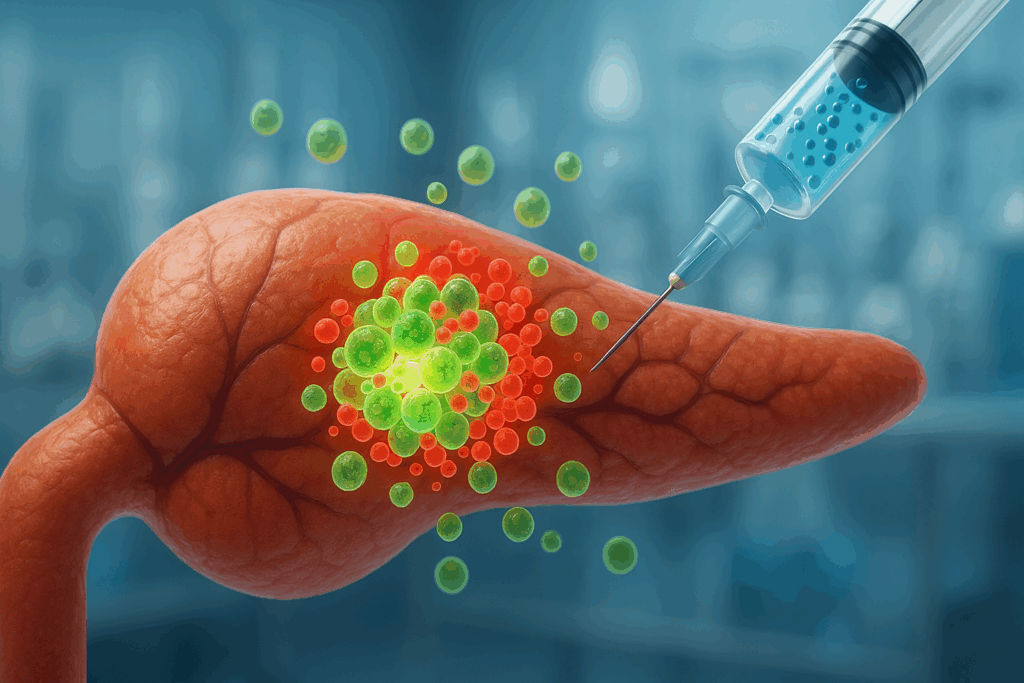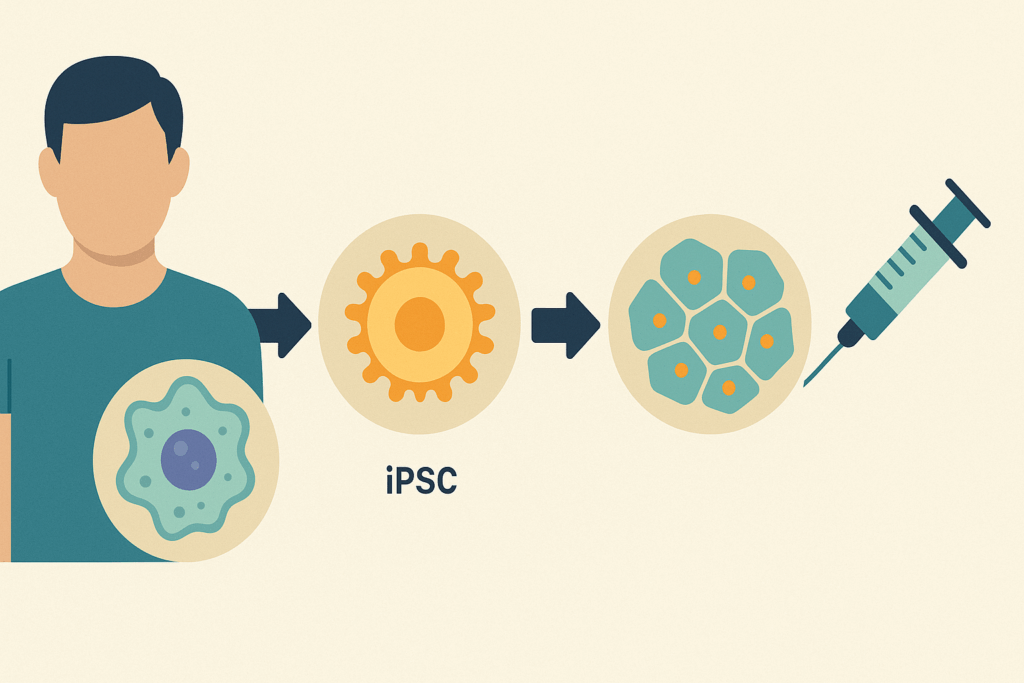A New Horizon in Diabetes Research: The Emergence of Cellular Therapy
Over the past few decades, type 2 diabetes has evolved into a global health crisis, with its burden particularly pronounced in densely populated regions such as China. Home to the largest diabetic population in the world, China has long been on the frontline of efforts to combat this chronic condition. Recently, however, a wave of optimism has emerged in the form of a novel therapeutic approach: cellular therapy. This cutting-edge development, which has been spearheaded by Chinese scientists, is redefining how we perceive and potentially treat type 2 diabetes. As researchers make headlines with claims that China discovers cure for diabetes, the global medical community is watching closely. Could it be that a viable, long-term solution to managing or even reversing type 2 diabetes has finally arrived?
You may also like: Breakthroughs in Current Diabetes Research: What the Latest Studies Reveal About Treatment and Prevention
The conversation around the so-called Chinese diabetes breakthrough is not without merit. Groundbreaking research out of prominent Chinese biomedical institutions has demonstrated encouraging results using cell-based interventions to restore normal glucose regulation. Unlike traditional pharmacological treatments, which often only manage symptoms or delay complications, these cellular therapies target the root cause—dysfunctional insulin-producing cells. As we explore this breakthrough, it becomes essential to distinguish fact from hyperbole and to understand how this research fits into the broader context of global diabetes care. In this article, we examine the scientific foundations, regulatory challenges, and future implications of what some are calling the most significant advance since insulin was first used to treat diabetes.

The Scientific Foundation of China’s Cell Therapy for Diabetes
At the heart of the Chinese cure for diabetes lies the use of stem cell and pancreatic progenitor cell technologies. These therapies aim to regenerate the beta cells within the pancreas—the very cells responsible for producing insulin. In individuals with type 2 diabetes, these beta cells either become dysfunctional or are unable to produce adequate amounts of insulin to regulate blood sugar effectively. Chinese scientists working in regenerative medicine have developed a technique whereby induced pluripotent stem cells (iPSCs) are reprogrammed to develop into insulin-producing cells.
This approach offers several advantages over traditional therapies. First, iPSCs can be derived from the patient’s own tissues, minimizing the risk of immune rejection. Second, once transplanted, these cells have shown the capacity to sense blood glucose levels and secrete insulin accordingly—essentially mimicking the function of a healthy pancreas. Early-phase clinical trials in China have already reported measurable improvements in glycemic control, reduced insulin dependency, and improved beta-cell function. These results are encouraging and lend credibility to the idea that China found cure for diabetes through scientifically rigorous means.
Further reinforcing the promise of this therapy is its potential to not just manage but fundamentally alter the trajectory of the disease. Unlike conventional treatments that require lifelong adherence, the new china diabetes cell therapy could provide long-term benefits with fewer interventions. This paradigm shift—from symptom management to disease modification—has the potential to transform not only patient outcomes but also public health policy.

Clinical Trials and Evidence Supporting the Breakthrough
Clinical evidence is often the ultimate litmus test for any new medical therapy. In recent years, multiple research centers across China have launched extensive clinical trials aimed at validating the efficacy and safety of this cellular intervention. These studies, supervised by both domestic regulatory agencies and international collaborators, have shown promising outcomes in key metabolic parameters.
Patients enrolled in early-phase trials have demonstrated significant reductions in HbA1c levels, fasting plasma glucose, and insulin resistance—all core indicators of improved diabetic control. Moreover, these changes were sustained over several months, indicating more than just a transient effect. In several documented cases, patients were able to discontinue their insulin therapy altogether, a result that would have been considered improbable just a decade ago. These success stories fuel ongoing interest and give substantial weight to claims that Chinese scientists cure diabetes through their pioneering research.
In addition to efficacy, safety remains a paramount concern. Thus far, no serious adverse events have been reported in the trials, although longer-term surveillance is essential to fully ascertain the therapy’s safety profile. Still, the lack of immediate immunological complications is a strong indicator that using autologous cells may indeed mitigate some of the historical risks associated with transplant-based interventions.
The growing body of clinical evidence is now serving as the basis for expanded trials involving larger and more diverse patient populations. This rigorous approach is crucial, especially considering the global scrutiny that accompanies any claim that china discovers cure for diabetes. Nonetheless, the evidence to date paints a hopeful picture, one that is grounded in methodical science rather than wishful thinking.

Ethical, Regulatory, and Geopolitical Considerations
The advent of such a potentially transformative therapy also brings with it a host of ethical and regulatory considerations. While the scientific achievements of Chinese scientists in diabetes research are undeniable, the road to widespread adoption is anything but straightforward. Regulatory approval, particularly from international bodies such as the U.S. FDA and the European Medicines Agency, requires extensive data and often years of vetting.
Moreover, the claim that china cures diabetes sanctions is not merely a scientific issue but a geopolitical one. In recent years, tensions between China and Western nations have impacted collaboration in health sciences, particularly in the sharing of intellectual property and joint clinical trials. Concerns over data transparency, patient consent protocols, and regulatory standards must be addressed to ensure global trust in these medical innovations.
Ethically, the use of stem cells—especially embryonic stem cells—remains a contentious issue in some jurisdictions. However, most of the recent breakthroughs in China have relied on iPSCs, which circumvent many of the traditional ethical dilemmas. Nonetheless, public perception and policy debates around stem cell use could still influence how quickly such therapies are adopted outside of China.
China’s position as both a scientific innovator and a political actor means that the path forward will be shaped by more than just clinical success. International dialogue, mutual regulatory recognition, and transparent reporting will be essential if the goal is truly to bring the benefits of this research to a global audience. After all, even the most remarkable china diabetes breakthrough is only as impactful as its ability to be integrated into real-world treatment protocols.

How the Therapy Works: A Closer Look at the Mechanism
To appreciate the magnitude of the china type 2 diabetes cure effort, it’s essential to understand the biological mechanisms underpinning this approach. The therapy generally begins with harvesting a small sample of somatic cells—often from the patient’s skin or blood. These cells are then reprogrammed into iPSCs using specific transcription factors. Once pluripotency is achieved, the iPSCs are directed to differentiate into pancreatic progenitor cells capable of insulin production.
This process, while conceptually elegant, is technically complex. Each stage must be tightly controlled to ensure cellular purity and functional viability. Once the insulin-producing cells are developed, they are encapsulated or engineered in such a way that they can be transplanted back into the patient with minimal immune interference. The encapsulation also serves to protect these cells from autoimmune attacks, which are common in various forms of diabetes.
Post-transplant, these cells integrate with the body’s endocrine system and begin to functionally replace damaged beta cells. Because they are genetically matched to the patient, the risk of rejection is significantly lower than with donor organs or allogenic cell therapies. The cells’ ability to respond to physiological glucose levels in real-time is what sets this therapy apart from conventional insulin injections, which often cannot replicate the nuanced regulatory dynamics of a healthy pancreas.
Understanding this mechanism also sheds light on why this therapy is garnering so much attention. It offers a targeted, biologically integrated solution that addresses the root cause of type 2 diabetes rather than merely controlling its symptoms. For those wondering whether china found cure for diabetes, this mechanistic clarity adds weight to the argument that the answer may indeed be yes—at least in the context of regenerative medicine.

Patient Perspectives and Societal Impact
The enthusiasm surrounding this chinese diabetes breakthrough is not confined to laboratories and academic journals. Patients across China are beginning to see firsthand the implications of this novel therapy. Testimonials from individuals who have participated in clinical trials paint a picture of renewed hope, improved quality of life, and, in many cases, substantial reductions in medication dependence.
For many, the idea that chinese scientists cure diabetes is more than a headline—it’s a lived experience. These patients describe a return to more normalized routines, reduced fears of complications, and a diminished psychological burden that often accompanies chronic illness. While it is essential to approach these anecdotes with scientific skepticism, they do offer qualitative evidence that complements the quantitative data emerging from clinical trials.
On a societal level, the successful implementation of this therapy could have profound implications. With diabetes consuming a significant portion of public health budgets—particularly in aging populations—the potential cost savings are enormous. Furthermore, improved disease control at the population level can translate into increased workforce productivity, lower hospitalization rates, and decreased incidence of diabetes-related complications such as kidney failure and cardiovascular disease.
The broader social narrative is also evolving. What was once seen as a lifelong, progressively debilitating condition is now being reframed as a potentially reversible metabolic dysfunction. This shift in perspective could alter how people approach lifestyle choices, treatment adherence, and long-term health planning. The notion that china diabetes 2 cure may be within reach has the power to reshape public health messaging in ways previously unimaginable.

The Road Ahead: Opportunities and Challenges
While optimism is warranted, it is also important to recognize the hurdles that remain. Scaling up production of personalized cell therapies is a logistical and financial challenge. Maintaining consistency in cell quality, ensuring sterility, and navigating complex supply chains are all critical factors that will determine whether this therapy can move from niche clinics to mainstream hospitals.
Furthermore, long-term data is still being collected. Although early results are promising, diabetes is a multifactorial disease influenced by genetics, environment, and behavior. It remains to be seen whether cell-based therapies will offer enduring benefits across such a diverse spectrum of patients. There is also the question of accessibility—will rural or economically disadvantaged populations be able to afford or access these treatments?
Nonetheless, the groundwork laid by chinese scientists in diabetes research is a testament to what can be achieved with targeted investment, interdisciplinary collaboration, and a bold vision. If the international community can rise to meet the regulatory and ethical challenges with equal rigor, then the dream that china discovers cure for diabetes may soon become a universally shared reality.
Frequently Asked Questions: China’s Breakthrough Cell Therapy for Type 2 Diabetes
1. How does the Chinese approach to diabetes treatment differ from Western strategies?
While Western medicine traditionally focuses on managing blood glucose levels through pharmaceutical agents, insulin therapy, and lifestyle interventions, the Chinese cure for diabetes introduces a more regenerative strategy. China diabetes cell therapy emphasizes the restoration of pancreatic function using patient-derived stem cells, aiming to eliminate insulin dependence altogether. This innovative approach, spearheaded by leading Chinese scientists in diabetes research, reflects a philosophical shift toward treating the root cause rather than just mitigating symptoms. It also aligns with traditional Chinese values of harmony and balance in the body, albeit using cutting-edge biotechnology. As China finds cure for diabetes through these regenerative methods, global healthcare systems are reevaluating the potential for integrated, long-term solutions.
2. What distinguishes the Chinese diabetes breakthrough from earlier stem cell research?
The uniqueness of the Chinese diabetes breakthrough lies in its precision and personalization. Earlier stem cell research faced challenges related to immune rejection and poor cell differentiation. However, the recent protocols developed by Chinese scientists cure diabetes by using autologous induced pluripotent stem cells (iPSCs), which significantly reduce immunogenic risks. Furthermore, advances in gene editing and cell encapsulation in China have refined these therapies, making them more efficient and safer. With reports that China discovers cure for diabetes through these advanced techniques, it marks a clear evolution from experimental concepts to practical, clinical applications.
3. Could China’s cell therapy model be replicated globally?
Adapting China diabetes cell therapy on a global scale would require extensive infrastructural, regulatory, and educational investments. The precision technologies used by Chinese researchers are highly specialized, and replicating such efforts demands trained personnel and quality-controlled biomanufacturing facilities. Additionally, international approval pathways differ widely, which can delay global adoption even when breakthroughs are validated. However, as Chinese scientists diabetes research continues to demonstrate efficacy, many countries are exploring pilot programs and partnerships to facilitate knowledge transfer. This growing interest suggests that, in time, China found cure for diabetes could transition from a national achievement to a global standard.
4. What social and psychological effects might arise from a functional cure for type 2 diabetes?
The availability of a credible, biologically grounded solution like the china type 2 diabetes cure could profoundly alter the psychological landscape of chronic disease. Many patients living with diabetes face long-term stress, depression, and fear of complications, which can impede effective disease management. Knowing that a curative therapy is available may foster hope, encourage greater healthcare engagement, and reduce the stigma often associated with chronic illness. In societies where healthcare systems are overwhelmed, such as in parts of rural China, this could also reshape how families approach care. If Chinese scientists cure diabetes at scale, the broader emotional relief experienced by patients and caregivers may be as impactful as the clinical outcomes.
5. Are there any risks of overhyping China’s diabetes research?
Yes, overhyping scientific breakthroughs can lead to misinformation, unrealistic expectations, and ethical concerns. While the results of the chinese diabetes breakthrough are promising, they must be tempered with transparency about clinical trial stages, long-term efficacy, and accessibility. Claims that china finds cure for diabetes should not be mistaken as an instantaneous or universally available solution. Additionally, policymakers and journalists must be cautious not to frame this achievement through the lens of geopolitical rivalry, such as linking it to china cures diabetes sanctions narratives, which can distort the scientific integrity of the research. Responsible communication and peer-reviewed publication are crucial to ensuring the public understands the science and its limitations.
6. How might China’s diabetes cell therapy affect global healthcare economics?
If widely adopted, china diabetes cell therapy could significantly alter the financial landscape of chronic disease management. Currently, diabetes accounts for hundreds of billions of dollars in global healthcare spending, including medication, hospitalization, and productivity losses. A therapy that can reverse or permanently control type 2 diabetes would potentially reduce these recurring costs. However, the initial investment in cell therapy infrastructure could be substantial. As China found cure for diabetes, the challenge for global health systems will be balancing upfront innovation costs with the promise of long-term savings and improved public health outcomes.
7. Could these advances shift the pharmaceutical industry’s approach to chronic disease?
Absolutely. The success of chinese scientists diabetes research is already prompting pharmaceutical companies to rethink their R&D priorities. Instead of focusing solely on symptom-suppressing drugs, some are exploring partnerships in regenerative medicine and biologics. A viable china type 2 diabetes cure demonstrates that it is possible to disrupt the conventional model of lifelong medication. However, this shift may also create tensions as traditional drug sales models are challenged by one-time or short-duration curative therapies. As more entities recognize that China discovers cure for diabetes through targeted biological innovation, the industry is likely to witness a realignment toward sustainable and curative modalities.
8. How are patient communities responding to the news of this breakthrough?
Diabetes support communities, particularly in Asia, have responded with cautious optimism to news about the chinese cure for diabetes. Online forums, patient advocacy groups, and wellness networks are abuzz with discussions about how soon these treatments might become accessible. Many individuals are exploring whether they qualify for clinical trials or how they can travel to participate in the procedures. Despite the enthusiasm, patient leaders are emphasizing the need to manage expectations and avoid misinformation. Still, the widespread interest reflects the genuine hope that china diabetes breakthrough brings to millions who previously saw no alternative to lifelong management.
9. Could geopolitical factors limit access to China’s cell therapy for diabetes?
Unfortunately, access may be influenced by global politics, particularly in the context of china cures diabetes sanctions and regulatory restrictions. Tensions between major economic powers could hamper research collaborations, data sharing, and the export of biotechnology tools. This is especially concerning given that the expertise required to produce the therapy is not yet widespread. If countries restrict intellectual property exchanges or delay approvals for political reasons, patients worldwide may suffer. Therefore, it’s imperative that the global medical community advocate for open science and neutral healthcare diplomacy, ensuring the benefits of china diabetes cell therapy are not confined by borders.
10. What future innovations might build on this diabetes breakthrough?
The china diabetes 2 cure sets the stage for further innovations in precision medicine and bioengineering. For example, researchers are already exploring how artificial intelligence can optimize cell differentiation protocols and predict patient responsiveness. Others are investigating whether similar cell therapies could address co-occurring metabolic conditions like obesity or fatty liver disease. Some even foresee implantable bio-devices that combine living cells with electronic sensors to provide real-time glucose regulation. As chinese scientists cure diabetes with increasingly sophisticated tools, their work is likely to spark a cascade of breakthroughs that go far beyond a single disease and reshape chronic care as we know it.
Conclusion: Reflecting on the Global Significance of China’s Diabetes Breakthrough
The notion that china finds cure for diabetes is no longer a distant hope but a burgeoning reality supported by empirical research, clinical trials, and evolving treatment paradigms. The work of Chinese scientists has not only advanced our understanding of diabetes but also offered a glimpse into a future where chronic disease management is driven by restoration rather than mitigation.
As countries around the world grapple with the economic and human costs of type 2 diabetes, the innovations emerging from China offer both a challenge and an opportunity. They challenge outdated assumptions about disease irreversibility and offer an opportunity to reimagine healthcare delivery. The emergence of the china diabetes cell therapy may well mark the beginning of a new chapter—one where biology, technology, and human perseverance converge to overcome one of the most persistent public health challenges of our time.
In reflecting on this progress, it becomes clear that the implications extend far beyond national borders. If regulatory and geopolitical barriers can be navigated with wisdom and cooperation, then the dream that china type 2 diabetes cure can benefit the world becomes entirely plausible. Through transparency, collaboration, and continued scientific excellence, the story of how chinese scientists cure diabetes may one day be recounted as one of the defining medical milestones of the 21st century.
Further Reading:
Chinese scientists develop cure for diabetes, insulin patient becomes medicine-free in just 3 months
Breakthrough in human induced pluripotent stem cell research of a functional cure for type 1 diabetes
Stem Cell Therapy Achieves First-Ever Cure for Type 2 Diabetes
Disclaimer
The information contained in this article is provided for general informational purposes only and is not intended to serve as medical, legal, or professional advice. While MedNewsPedia strives to present accurate, up-to-date, and reliable content, no warranty or guarantee, expressed or implied, is made regarding the completeness, accuracy, or adequacy of the information provided. Readers are strongly advised to seek the guidance of a qualified healthcare provider or other relevant professionals before acting on any information contained in this article. MedNewsPedia, its authors, editors, and contributors expressly disclaim any liability for any damages, losses, or consequences arising directly or indirectly from the use, interpretation, or reliance on any information presented herein. The views and opinions expressed in this article are those of the author(s) and do not necessarily reflect the official policies or positions of MedNewsPedia.


